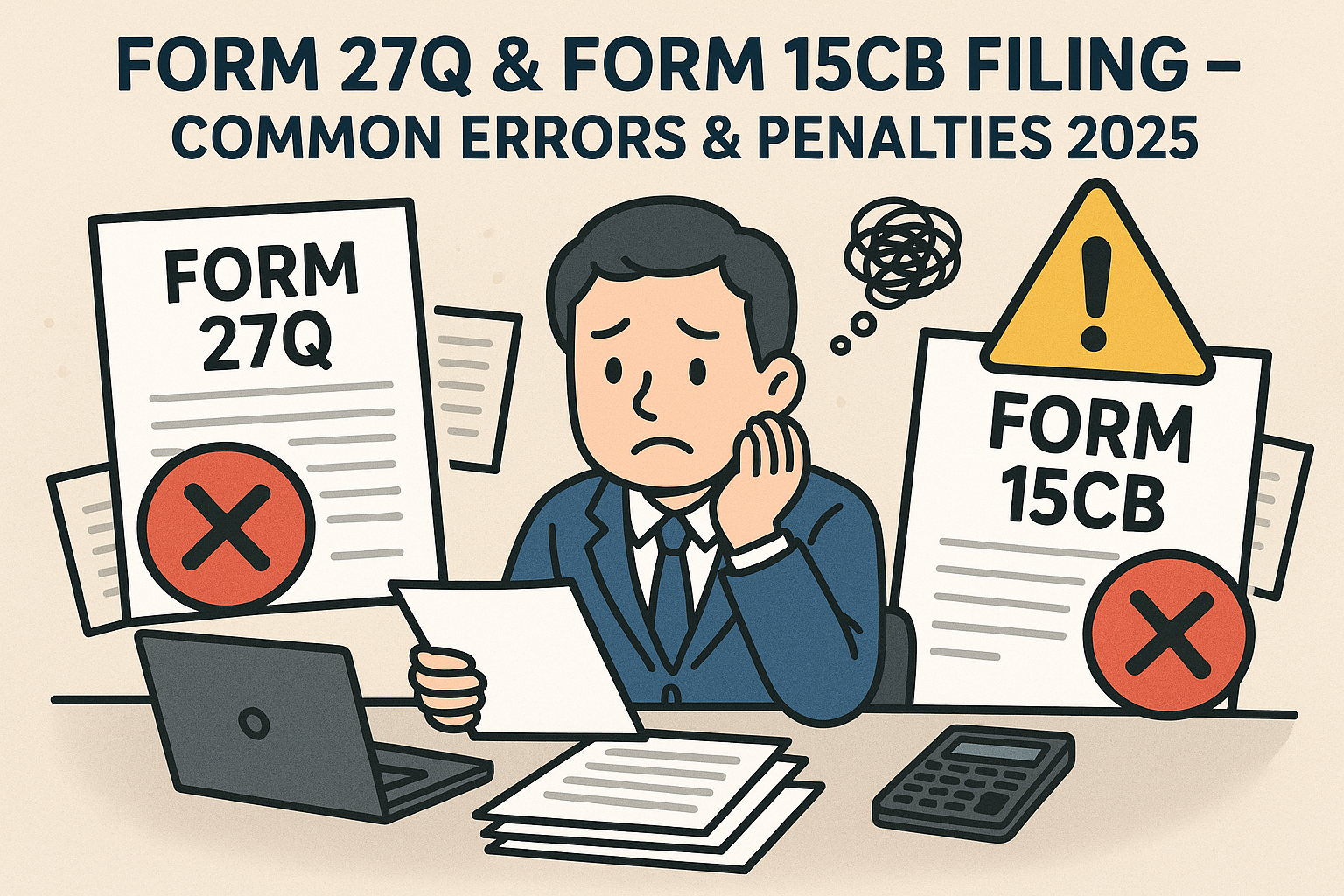Dealing with foreign payments? Then you’re likely familiar with Form 27Q and Form 15CB under the Indian Income Tax Act.
But small errors in filing can lead to hefty penalties, TDS mismatches, or even payment blocks by banks.
Table of Contents
What is Form 27Q?
Form 27Q is a TDS return for non-residents (including NRIs and foreign companies).
It must be filed if you deduct TDS while making any payment to a foreign party.
Examples:
- Freelancers hiring foreign consultants
- Companies paying for software subscriptions
- Payments for services or interest outside India
It contains:
- PAN of payee
- TDS amount deducted
- Nature of payment
- Date of deduction
- Challan details
Quarterly filing is mandatory (like Form 26Q for residents).
What is Form 15CB?
Form 15CB is a CA Certificate under Section 195.
It is needed when a foreign remittance is taxable and TDS is deducted.
Purpose? To certify:
- Nature of payment
- Whether it’s taxable in India
- Applicable TDS rate (with or without DTAA)
- Compliance with FEMA & Income Tax rules
Step-by-Step to File Form 15CB Online
Step 1: Chartered Accountant Login
- Go to the official Income Tax e-Filing portal: https://www.incometax.gov.in
- Login using your CA login credentials
Step 2: Navigate to Form 15CB
- Go to:
e-File → Income Tax Forms → File Income Tax Forms - Search and select Form 15CB
- Click “File Now”
Step 3: Fill Form 15CB
Provide the following information:
A. Remitter Details
- Name, PAN, Address
- Residential status
B. Remittee (Foreign Party) Details
- Name, Country, Address
- Tax Residency (as per DTAA)
C. Payment Details
- Nature of payment (royalty, interest, consultancy, etc.)
- Invoice amount and currency
- Purpose code (as per RBI)
D. Taxability & DTAA Info
- Whether the payment is taxable
- TDS rate under the Income Tax Act
- TDS rate under DTAA (if lower)
- Relevant DTAA Article
- Whether PAN of remittee is available
E. TDS Info
- TDS amount
- Challan details (number, date, amount)
- Payment date
Step 4: Sign Using DSC
- Attach your Digital Signature Certificate (DSC)
- Click Submit
After filing, the form is visible to the remitter in their login for linking with Form 15CA.
This form is uploaded on the Income Tax portal by your Chartered Accountant.
When is Form 15CB + 15CA Required?
| Type of Payment | 15CB Required? | 15CA Part |
|---|---|---|
| Payment > ₹5 lakh, taxable in India | Yes | Part C |
| Payment < ₹5 lakh, taxable | No | Part A |
| Payment exempt or not taxable | No | Part D (Self-declaration) |
| Under DTAA with TRC | Yes | Part C + 15CB with DTAA benefit |
Common Errors in Form 27Q & 15CB Filing
- Wrong PAN or missing PAN of foreign party
- Incorrect TDS section used (e.g., 195 vs 194E)
- Mismatch in TDS rate or nature of income
- Filing TDS under 26Q instead of 27Q
- Not uploading Form 15CB on portal before remittance
- Not mentioning correct DTAA article / country
- 15CB filed but no 27Q filed (or vice versa)
What are the Penalties?
| Mistake | Penalty | Section |
|---|---|---|
| Late filing of 27Q | ₹200/day | Section 234E |
| Incorrect or non-filing | ₹10,000 – ₹1,00,000 | Section 271H |
| Not deducting TDS at all | 30% to 100% of tax | Section 201 |
| Wrong 15CB info | CA may face penalty & client may get notice | – |
Difference: 234E vs. 271H
| Section | What it Charges For | Nature |
|---|---|---|
| 234E | Late filing of TDS return | Fee (Compulsory) |
| 271H | Incorrect info or non-filing | Penalty (Discretionary by AO) |
Bank may also refuse your foreign payment if 15CB or 15CA not filed correctly.
How to Avoid These Issues?
- Hire a qualified CA familiar with foreign TDS
- Get Tax Residency Certificate (TRC) of foreign party if DTAA applicable
- Always file 15CB before sending money
- Cross-verify 27Q with 15CB & remittance documents
- Keep records of invoices, contracts & bank advice slips
Final Words
Many businesses and freelancers make avoidable mistakes in Form 27Q and Form 15CB, leading to TDS defaults, delayed remittances, or IT notices.
But if you’re a little careful, or work with the taxgiveindia.com consultant, you can stay fully compliant and avoid all penalties.
